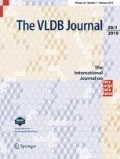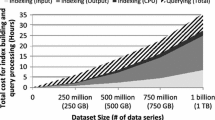Abstract
Data series (including time series) has attracted lots of interest in recent years. Most of the research has focused on how to efficiently support similarity or nearest neighbor queries over large data series collections (an important data mining task), and several data series summarization and indexing methods have been proposed in order to solve this problem. Up to this point, very little attention has been paid to properly evaluating such index structures, with most previous works relying solely on randomly selected data series to use as queries. In this work, we show that random workloads are inherently not suitable for the task at hand and we argue that there is a need for carefully generating query workloads. We define measures that capture the characteristics of queries, and we propose a method for generating workloads with the desired properties, that is, effectively evaluating and comparing data series summarizations and indexes. In our experimental evaluation, with carefully controlled query workloads, we shed light on key factors affecting the performance of nearest neighbor search in large data series collections. This is the first paper that introduces a method for quantifying hardness of data series queries, as well as the ability to generate queries of predefined hardness.



















Similar content being viewed by others
Notes
Note that when these values are measured over time (usually at fixed time intervals), we call them time series. However, time series are just one special case of data series: A series can also be defined over other measures (e.g., mass in mass spectroscopy, position in genome sequences, angle in radial chemical profiles, etc.). For the rest of this paper, we will use the terms sequence, data series, and time series interchangeably.
This work (built on our preliminary version [46]) includes a more precise formal definition of the problem, a deeper analysis of previous workloads, a robust geometric solution for placing nearest neighbors at predefined distances from a query that removes earlier limitations, and an expanded experimental evaluation section.
In this work, we use the well-known FFT algorithm.
Informally, the effort is the amount of work that an index needs to perform. We formally define the notion of effort later in this section.
A similar definition has been proposed in the past [5].
We also use the same datasets in our experimental section.
ftp://ftp.ensembl.org/pub/release-42/
This algorithm iterates over all symbols in the DNA sequence and constructs the series as a cumulative sum, which increases by 2 for every appearance of the base “A,” by 1 for “G” and decreases by 1 and 2 for each appearance of “C” and “T,” respectively.
References
Agrawal, R., Faloutsos, C., Swami, A.: Efficient similarity search in sequence databases. In: FODO (1993)
Assent, I., Krieger, R., Afschari, F., Seidl, T.: The ts-tree: Efficient time series search and retrieval. In: EDBT (2008)
Bagnall, A., Lines, J., Bostrom, A., Large, J., Keogh, E.J.: The great time series classification bake off: a review and experimental evaluation of recent algorithmic advances. Data Min. Knowl. Discov. 31(3), 606–660 (2017). https://doi.org/10.1007/s10618-016-0483-9
Bay, S.D., Kibler, D., Pazzani, M.J., Smyth, P.: The uci kdd archive of large data sets for data mining research and experimentation. In: SIGKDD Explorations (2000)
Beyer, K., Goldstein, J., Ramakrishnan, R., Shaft, U.: When is “nearest neighbor" meaningful? In: ICDT (1999)
Camerra, A., Palpanas, T., Shieh, J., Keogh, E.: iSAX 2.0: Indexing and mining one billion time series. In: ICDM (2010)
Camerra, A., Shieh, J., Palpanas, T., Rakthanmanon, T., Keogh, E.: Beyond one billion time series: indexing and mining very large time series collections with isax2+. KAIS (2013)
Chakrabarti, K., Keogh, E., Mehrotra, S., Pazzani, M.: Locally adaptive dimensionality reduction for indexing large time series databases. In: SIGMOD (2002)
Chan, K.P., Fu, A.C.: Efficient time series matching by wavelets. In: ICDE (1999)
Chen, Q., Chen, L., Lian, X., Liu, Y., Yu, J.X.: Indexable pla for efficient similarity search. In: VLDB (2007)
Chow, C., Mokbel, M.F., Bao, J., Liu, X.: Query-aware location anonymization for road networks. GeoInformatica 15(3), 571–607 (2011). https://doi.org/10.1007/s10707-010-0117-0
Dallachiesa, M., Nushi, B., Mirylenka, K., Palpanas, T.: Uncertain time-series similarity: Return to the basics. In: VLDB (2012)
Dallachiesa, M., Palpanas, T., Ilyas, I.F.: Top-k nearest neighbor search in uncertain data series. In: VLDB (2015)
Das, G., Gunopulos, D., Mannila, H.: Finding similar time series. In: Principles of Data Mining and Knowledge Discovery, First European Symposium, PKDD ’97, Trondheim, Norway, June 24-27, 1997, Proceedings, pp. 88–100 (1997). https://doi.org/10.1007/3-540-63223-9_109
Faloutsos, C., Ranganathan, M., Manolopoulos, Y.: Fast subsequence matching in time-series databases. In: SIGMOD (1994)
Fu, A.W., Leung, O.T., Keogh, E.J., Lin, J.: Finding time series discords based on haar transform. In: Advanced Data Mining and Applications, Second International Conference, ADMA 2006, Xi’an, China, August 14-16, 2006, Proceedings, pp. 31–41 (2006). https://doi.org/10.1007/11811305_3
Goldin, D.Q., Kanellakis, P.C.: On similarity queries for time-series data: Constraint specification and implementation. In: Principles and Practice of Constraint Programming (1995)
Guttman, A.: R-trees: A dynamic index structure for spatial searching. In: SIGMOD (1984)
Huijse, P., Estévez, P.A., Protopapas, P., Principe, J.C., Zegers, P.: Computational intelligence challenges and applications on large-scale astronomical time series databases. IEEE Comp. Int. Mag. 9(3), 27–39 (2014)
Kashino, K., Smith, G., Murase, H.: Time-series active search for quick retrieval of audio and video. In: ICASSP (1999)
Kashyap, S., Karras, P.: Scalable knn search on vertically stored time series. In: KDD (2011)
Keogh, E.: Machine learning in time series databases (and everything is a time series!). In: Tutorial at the AAAI International Conference on Artificial Intelligence, vol. 2 (2011)
Keogh, E., Chakrabarti, K., Pazzani, M., Mehrotra, S.: Dimensionality reduction for fast similarity search in large time series databases. KAIS 3 (2000)
Keogh, E., Pazzani, M.: Scaling up dynamic time warping to massive datasets. In: PKDD (1999)
Korn, F., Jagadish, H.V., Faloutsos, C.: Efficiently supporting ad hoc queries in large datasets of time sequences. In: SIGMOD (1997)
Kremer, H., Günnemann, S., Ivanescu, A.M., Assent, I., Seidl, T.: Efficient processing of multiple dtw queries in time series databases. In: SSDBM (2011)
Li, C.S., Yu, P., Castelli, V.: Hierarchyscan: a hierarchical similarity search algorithm for databases of long sequences. In: ICDE (1996)
Lin, J., Keogh, E., Lonardi, S., Chiu, B.: A symbolic representation of time series, with implications for streaming algorithms. In: DMKD (2003)
Lin, J., Keogh, E.J., Wei, L., Lonardi, S.: Experiencing SAX: a novel symbolic representation of time series. Data Min. Knowl. Discov. 15(2), 107–144 (2007)
Lin, J., Khade, R., Li, Y.: Rotation-invariant similarity in time series using bag-of-patterns representation. J. Intell. Inf. Syst. 39(2), 287–315 (2012)
Prabhakar, S., Xia, Y., Kalashnikov, D.V., Aref, W.G., Hambrusch, S.E.: Query indexing and velocity constrained indexing: scalable techniques for continuous queries on moving objects. IEEE Trans. Comput. 51(10), 1124–1140 (2002). https://doi.org/10.1109/TC.2002.1039840
Rafiei, D., Mendelzon, A.: Similarity-based queries for time series data. In: SIGMOD (1997)
Rafiei, D., Mendelzon, A.: Efficient retrieval of similar time sequences using dft. In: ICDE (1998)
Rakthanmanon, T., Campana, B., Mueen, A., Batista, G., Westover, B., Zhu, Q., Zakaria, J., Keogh, E.: Searching and mining trillions of time series subsequences under dynamic time warping. In: KDD (2012)
Ratanamahatana, C.A., Lin, J., Gunopulos, D., Keogh, E.J., Vlachos, M., Das, G.: Mining time series data. In: Data Mining and Knowledge Discovery Handbook, 2nd ed., pp. 1049–1077 (2010). https://doi.org/10.1007/978-0-387-09823-4_56
Ravi Kanth, K.V., Agrawal, D., Singh, A.: Dimensionality reduction for similarity searching in dynamic databases. In: SIGMOD (1998)
Schäfer, P., Högqvist, M.: Sfa: A symbolic fourier approximation and index for similarity search in high dimensional datasets. In: EDBT (2012)
Shasha, D.: Tuning time series queries in finance: Case studies and recommendations. IEEE Data Eng. Bull. 22(2), 40–46 (1999)
Shieh, J., Keogh, E.: isax: Indexing and mining terabyte sized time series. In: KDD (2008)
Wang, X., Mueen, A., Ding, H., Trajcevski, G., Scheuermann, P., Keogh, E.: Experimental comparison of representation methods and distance measures for time series data. DMKD 26(2), 275–309 (2013)
Wang, Y., Wang, P., Pei, J., Wang, W., Huang, S.: A data-adaptive and dynamic segmentation index for whole matching on time series. In: VLDB (2013)
Ye, L., Keogh, E.J.: Time series shapelets: a new primitive for data mining. In: KDD (2009)
Yi, B.K., Jagadish, H., Faloutsos, C.: Efficient retrieval of similar time sequences under time warping. In: ICDE (1998)
Zoumpatianos, K., Idreos, S., Palpanas, T.: Indexing for interactive exploration of big data series. In: SIGMOD (2014)
Zoumpatianos, K., Idreos, S., Palpanas, T.: Rinse: Interactive data series exploration. In: VLDB (2015)
Zoumpatianos, K., Lou, Y., Palpanas, T., Gehrke, J.: Query workloads for data series indexes. In: Proceedings of the 21th ACM SIGKDD International Conference on Knowledge Discovery and Data Mining, Sydney, NSW, Australia, August 10-13, 2015, pp. 1603–1612 (2015)
Author information
Authors and Affiliations
Corresponding author
Rights and permissions
About this article
Cite this article
Zoumpatianos, K., Lou, Y., Ileana, I. et al. Generating data series query workloads. The VLDB Journal 27, 823–846 (2018). https://doi.org/10.1007/s00778-018-0513-x
Received:
Revised:
Accepted:
Published:
Issue Date:
DOI: https://doi.org/10.1007/s00778-018-0513-x




